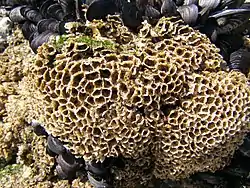Sabellaria alveolata
Sabellaria alveolata, (also known as the honeycomb worm), is a reef-forming polychaete. It is distributed around the Mediterranean Sea, and from the north Atlantic Ocean to south Morocco. It is also found in the British Isles at its northern limit in the northeast Atlantic.[2] Its common name is derived from the honeycomb-like pattern it creates when building its tube reefs.
| Honeycomb worm[1] | |
|---|---|
 | |
| Scientific classification | |
| Kingdom: | Animalia |
| Phylum: | Annelida |
| Class: | Polychaeta |
| Family: | Sabellariidae |
| Genus: | Sabellaria |
| Species: | S. alveolata |
| Binomial name | |
| Sabellaria alveolata | |
Description

Sabellaria alveolata is an annelid (ringed worm) that lives in small tubes it constructs from cemented coarse sand and/or shell material, forming reefs.[2] The tubes are arranged in close proximity and have a distinctive honeycomb-like appearance.[3] These reefs range from 30 centimetres (12 in) to 2 metres (6.6 ft)[4] thick and take the form of hummocks, sheets or more massive formations.[3] Adult size ranges from 30 to 40 millimetres (1.2 to 1.6 in).[2] The thorax has three pairs of flattened chaetal sheaths, its chaetes form an operculum which is used to seal the tube opening.[2] Depending on the local substrate, the colour of the tube varies.[2]
Distribution
Sabellaria alveolata is found in the Mediterranean and the north Atlantic from Britain south to Morocco. In Britain and Ireland it is mainly found on southern and western coasts from the Western Isles to Cornwall.[5]
Habitat and ecology
Sabellaria alveolata occurs on the bottom third or so of the intertidal zone and in the shallow subtidal zone. The worms construct different types of structures depending on the conditions. Where it occurs along rocky shorelines among bladderwrack then the agglomeration of tubes vary from thin encrustations if they are present at low densities to dense hummocks and mounds where there is a high density. The tubes are built from shell fragments or sand and are used to protect the worm from predators and can be repaired if damaged near the entrance. The tube is made up of a number of overlapping layers of material glued together with mucus. There are two sexes and spawning takes place in the Spring and again in the Autumn. The larvae develop in the water column and can detect the substance the adults use to bind their tubes and follow this to find a location to settle on. They are filter feeders and use cilia covered tentacles to extract food from the water. The reefs that they build encourage biodiversity.[6]
Conservation
Sabellaria alveolata is a United Kingdom, Biodiversity Action Plan species and the plan was published in 1994 and as part of the plan the reefs were mapped and surveyed.[6] They are included on local Biodiversity Action Plans such as that for Newry, Mourne and Down in Northern Ireland to ensure local protection.[7]
References
- Gérard Bellan (2011). Read G, Fauchald K (eds.). "Sabellaria alveolata (Linnaeus, 1767)". World Polychaeta database. World Register of Marine Species. Retrieved December 6, 2011.
- "Honeycomb worm". Grzimek's Animal Life Encyclopedia. Gale. 2003. Retrieved 2009-08-01.
- Moffat A (1999). "Action plan for Sabellaria alveolata reefs". United Kingdom Biodiversity Action Plan. Retrieved 2009-08-05.
- Hermelles
- Jackson, A. (2008). Tyler-Walters H.; Hiscock K. (eds.). "Sabellaria alveolata Honeycomb worm". Marine Life Information Network: Biology and Sensitivity Key Information Reviews, [on-line]. Plymouth. Marine Biological Association of the United Kingdom. Retrieved 2 March 2020.
- "Honeycomb Worm Biology". The REEHAB Project. Retrieved 25 March 2020.
- "Newry, Mourne and Down Local Biodiversity Action Plan 2017-2022" (PDF). Newry, Mourne and Down District Council. Retrieved 25 March 2020.
| Wikimedia Commons has media related to Sabellaria alveolata. |